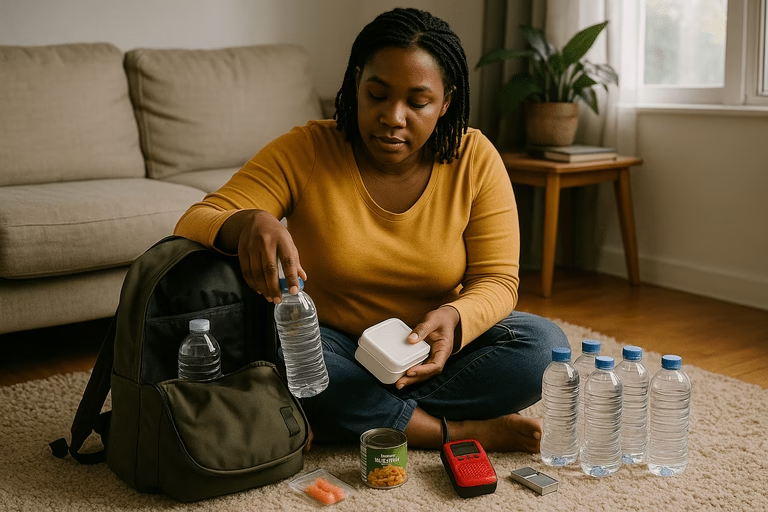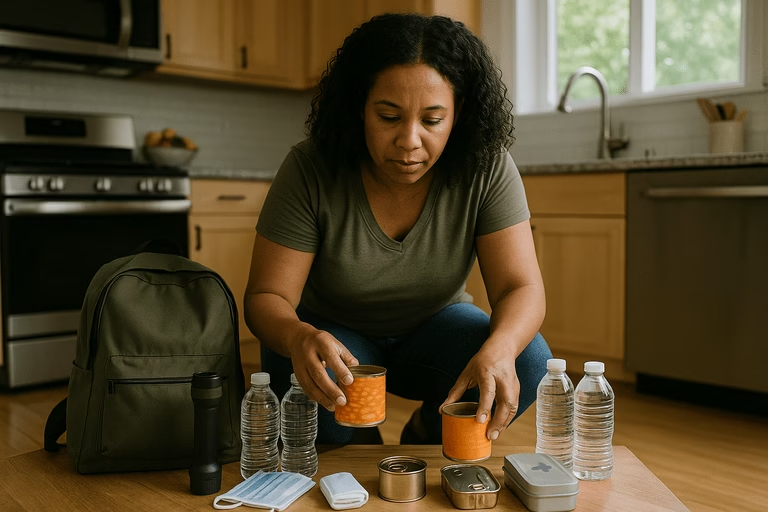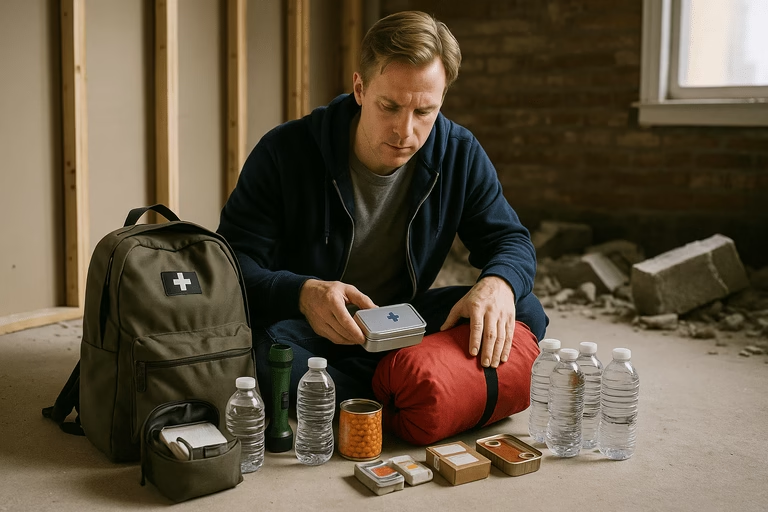Earthquakes can strike at any time, without warning. Unlike hurricanes or storms, they offer little to no time to react. Therefore, preparing an earthquake survival kit in advance is a vital step in protecting yourself and your family. It isn’t about panic—it’s about being responsible.
Most people believe emergency services will reach them immediately after a disaster, but in reality, responders may be delayed for hours or even days. For this reason, a self-sufficient plan is essential. With the right items on hand, you can stay safe, nourished, and informed while waiting for assistance.
What Exactly Is an Earthquake Survival Kit?
At its core, an earthquake survival kit is a collection of essential supplies designed to support you for at least 72 hours following a seismic event. These kits are portable, easy to store, and filled with tools to meet basic human needs: water, food, hygiene, warmth, medical care, and communication.
It’s not just about surviving the initial tremor; it’s also about making it through the aftermath. Aftershocks, blocked roads, damaged infrastructure, and widespread outages can leave you isolated. That’s why your kit should be robust, reliable, and tailored to your specific environment and household.

Essential Items to Include
A comprehensive earthquake survival kit should cover several categories. Begin with water—store one gallon per person per day. Add non-perishable food such as canned meats, peanut butter, granola, and ready-to-eat meals. Include a manual can opener if needed.
Next, pack first aid essentials: bandages, antiseptic wipes, adhesive tape, scissors, tweezers, pain relievers, and gloves. For communication, include a battery-powered or hand-crank radio, flashlight, extra batteries, and a loud whistle. These can help you stay informed and signal for help.
Bushcraft Survival Kit: Must-Have Items for Safety
In addition, don’t forget comfort items—blankets, ponchos, and a change of clothes. Even small things like playing cards or notebooks can help reduce stress during long waits. Each item should have a purpose, yet even emotional comfort matters in survival situations.
How to Customize an Earthquake Survival Kit for Your Family
Every family has unique needs. When building an earthquake survival kit, take into account the age, health, and mobility of each household member. For infants, pack formula, diapers, and baby wipes. For seniors, include extra medications and mobility aids.
In addition, don’t overlook your pets. Keep leashes, pet food, collapsible bowls, and a photo of your animal in case you’re separated. Furthermore, if anyone in your home has allergies, chronic conditions, or dietary restrictions, make sure your supplies reflect those needs.
Customize your kit for your location as well. For example, if you live in an earthquake-prone urban area, include N95 masks for dust, work gloves, and a small tool set. In rural regions, consider water purification tablets, maps, and extra fuel.

Where to Store Your Earthquake Survival Kit
Your earthquake survival kit must be stored in an easily accessible place—ideally near an exit or a commonly used room. You may only have seconds to grab it. Keep one full-size kit in your home and smaller versions in your car and at work.
Place the kit inside a waterproof, durable bag such as a tactical backpack, rolling duffel, or plastic bin with a secure lid. Make sure it’s easy to lift and transport. If you have a multi-level home, consider placing a smaller emergency kit on each floor.
In addition, inform every family member where the kit is and how to use it. Run a drill once every few months to ensure everyone knows what to do and where to go.
How to Maintain and Refresh Your Earthquake Survival Kit
Building an earthquake survival kit is just the beginning—keeping it current is equally important. Supplies expire, technology evolves, and your family’s needs may change. Therefore, set a reminder every six months to review and refresh your kit.
Check expiration dates on food, water, and medications. Test electronics like flashlights and radios to make sure they still function. In addition, update contact lists and medical records, especially if you’ve moved or changed providers. Replace worn-out items like elastic bandages or torn blankets immediately.
Survival Backpack Kit: Essential Gear for Emergencies
It’s also a good idea to adjust your kit seasonally. For instance, add hand warmers and thermal gear during winter, or sunscreen and electrolyte packs in summer. These adjustments ensure your kit is always ready for real-world conditions.
Budget-Friendly Tips for Building an Earthquake Survival Kit
While the idea of preparing for an emergency might feel financially overwhelming, building a reliable earthquake survival kit doesn’t have to break the bank. Start by gathering items you already have at home—blankets, canned food, plastic utensils, and old backpacks can form a solid foundation.
Next, look for sales on essentials like bottled water, first aid kits, and hygiene supplies. Discount stores and dollar shops often carry many useful items, such as flashlights, batteries, and canned goods. In addition, consider building your kit gradually—add one or two items per week until it’s complete.
You can also find downloadable checklists from emergency organizations, which help prioritize spending on the most critical items first. With planning and patience, you can assemble an effective kit without straining your finances.

Options: DIY vs. Pre-Made
You can build your own earthquake survival kit from scratch, or you can buy a pre-made version. Each option has advantages. DIY kits allow for full customization—you control the quality, type, and quantity of each item. This is ideal for families with special needs or specific local risks.
On the other hand, pre-made kits offer convenience and time savings. These are typically packaged for one to four people and include everything from food to water filtration systems. However, they may lack certain items that are personal to you, such as prescriptions or specialized medical tools.
Therefore, many people choose a hybrid approach—starting with a basic pre-made kit, then adding custom items to fit their unique circumstances.
What to Do After Using Your Earthquake Survival Kit
If you ever need to use your earthquake survival kit, take time afterward to restock and assess its effectiveness. Make a list of what worked well, what you didn’t use, and what was missing. This feedback loop ensures that your kit evolves and stays optimized.
Survival Backpack Kit: Essential Gear for Emergencies
In addition, if you notice you relied heavily on one item (for example, water or a flashlight), consider doubling your supply. Likewise, if you found certain items bulky or hard to access, repackage or reposition them within the kit. Practical experience will always reveal areas for improvement.
Finally, talk to others about your experience. Sharing lessons learned can help neighbors and loved ones improve their own preparedness, which ultimately creates a safer community for everyone.
Quick Recap
Here’s a summary of everything you’ve learned about assembling and maintaining an effective earthquake survival kit:
- Plan ahead: Earthquakes come without warning, so readiness is key
- Cover the basics: Water, food, first aid, warmth, light, communication
- Customize per person: Include baby, pet, and senior care essentials
- Store properly: Use a durable bag in an accessible location
- Update regularly: Refresh supplies, documents, and batteries every 6 months
- Keep one at work and in the car for added security
- Adapt for local risks: Dust masks, tools, purification tablets, etc.
- Stay budget-friendly: Build slowly, reuse home items, and buy on sale
- Use drills and family training to improve response time
- Evaluate and improve after every real-world use or simulation
Final Thoughts: Prepare Today for Peace of Mind Tomorrow
Investing the time to build and maintain an earthquake survival kit gives you control in one of life’s most unpredictable situations. While you can’t stop an earthquake, you can absolutely improve your outcome with the right resources and mindset.
In addition, your preparation can influence others. By sharing your checklist, encouraging conversations, and educating those around you, you contribute to a culture of resilience. Natural disasters are inevitable, but how we respond—and prepare—makes all the difference.
Don’t wait for the ground to shake to take action. Start building your earthquake survival kit today—and take one powerful step toward protecting everything that matters.

